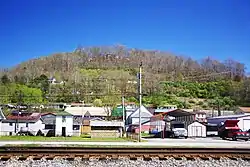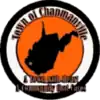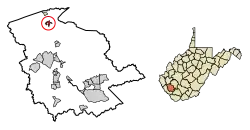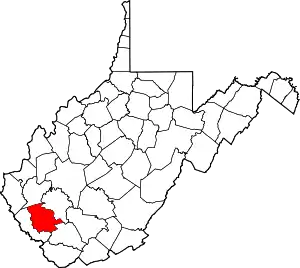Chapmanville, West Virginia
Chapmanville is a town in Logan County, West Virginia, United States. The population was 1,025 at the 2020 census.[2] Chapmanville is named for Ned Chapman, an early settler who operated a store and post office.[5] It was incorporated in 1947.[6]
Chapmanville, West Virginia | |
|---|---|
 Chapmanville | |
 Flag  Seal Logo | |
 Location of Chapmanville in Logan County, West Virginia. | |
| Coordinates: 37°58′18″N 82°1′12″W | |
| Country | United States |
| State | West Virginia |
| County | Logan |
| Area | |
| • Total | 0.68 sq mi (1.76 km2) |
| • Land | 0.66 sq mi (1.70 km2) |
| • Water | 0.02 sq mi (0.06 km2) |
| Elevation | 640 ft (195 m) |
| Population | |
| • Total | 1,025 |
| • Estimate (2021)[2] | 1,001 |
| • Density | 1,665.14/sq mi (642.93/km2) |
| Time zone | UTC-5 (Eastern (EST)) |
| • Summer (DST) | UTC-4 (EDT) |
| ZIP code | 25508 |
| Area code(s) | 304 & 681 |
| FIPS code | 54-14524[3] |
| GNIS feature ID | 1537207[4] |
| Website | https://townofchapmanville.com |
Geography
Chapmanville is located in northern Logan County at 37°58′18″N 82°1′12″W (37.971615, -82.020017).[7] It is situated between the mouth of Crawley Creek and Godby Branch along the Guyandotte River at a point where the northward-flowing river briefly bends sharply southwestwardly before turning north again.[8]
U.S. Route 119 and West Virginia Route 10, both of which approach from Logan to the south, intersect in Chapmanville. From this intersection, WV 10 continues northward in the direction of Huntington, while US 119 veers northeastward toward Charleston.
According to the United States Census Bureau, the town has a total area of 0.67 square miles (1.74 km2), of which 0.65 square miles (1.68 km2) is land and 0.02 square miles (0.05 km2) is water.[9]
Demographics
| Census | Pop. | Note | %± |
|---|---|---|---|
| 1950 | 1,349 | — | |
| 1960 | 1,241 | −8.0% | |
| 1970 | 1,175 | −5.3% | |
| 1980 | 1,164 | −0.9% | |
| 1990 | 1,110 | −4.6% | |
| 2000 | 1,211 | 9.1% | |
| 2010 | 1,256 | 3.7% | |
| 2020 | 1,025 | −18.4% | |
| 2021 (est.) | 1,001 | [2] | −2.3% |
| U.S. Decennial Census[10] | |||
2010 census
As of the census[11] of 2010, there were 1,256 people, 604 households, and 338 families living in the town. The population density was 1,932.3 inhabitants per square mile (746.1/km2). There were 667 housing units at an average density of 1,026.2 per square mile (396.2/km2). The racial makeup of the town was 98.2% White, 0.2% African American, 0.6% Asian, 0.4% from other races, and 0.6% from two or more races. Hispanic or Latino of any race were 1.4% of the population.
There were 604 households, of which 26.7% had children under the age of 18 living with them, 38.7% were married couples living together, 12.4% had a female householder with no husband present, 4.8% had a male householder with no wife present, and 44.0% were non-families. 40.2% of all households were made up of individuals, and 21.2% had someone living alone who was 65 years of age or older. The average household size was 2.08 and the average family size was 2.77.
The median age in the town was 42.4 years. 18.4% of residents were under the age of 18; 7.2% were between the ages of 18 and 24; 27.1% were from 25 to 44; 27.5% were from 45 to 64; and 19.7% were 65 years of age or older. The gender makeup of the town was 46.1% male and 53.9% female.
2000 census
As of the census[3] of 2000, there were 1,211 people, 581 households, and 330 families living in the town. The population density was 1,797.4 inhabitants per square mile (697.9/km2). There were 658 housing units at an average density of 976.6 per square mile (379.2/km2). The racial makeup of the town was 98.84% White, 0.74% Asian, and 0.41% from two or more races. Hispanic or Latino of any race were 0.41% of the population.
There were 581 households, out of which 23.1% had children under the age of 18 living with them, 40.8% were married couples living together, 13.8% had a female householder with no husband present, and 43.2% were non-families. 40.3% of all households were made up of individuals, and 20.0% had someone living alone who was 65 years of age or older. The average household size was 2.08 and the average family size was 2.82.
In the town, the population was spread out, with 19.0% under the age of 18, 9.5% from 18 to 24, 26.5% from 25 to 44, 25.1% from 45 to 64, and 19.9% who were 65 years of age or older. The median age was 41 years. For every 100 females, there were 77.0 males. For every 100 females age 18 and over, there were 76.4 males.
The median income for a household in the town was $23,077, and the median income for a family was $38,250. Males had a median income of $28,500 versus $20,769 for females. The per capita income for the town was $15,581. About 12.1% of families and 20.3% of the population were below the poverty line, including 31.7% of those under age 18 and 16.4% of those age 65 or over.
History
Captain Farley's Raid
Captain Henry Farley, a veteran of the Revolutionary War and resident of Montgomery County, Virginia, was the first known Anglo visitor to present-day Chapmanville. In June 1792, Captain Farley passed through the area while pursuing a Native American war party that had raided Virginia settlements at Bluestone River. By the time he reached what is today Chapmanville, he and his group had already engaged the retreating natives in the headwaters of Coal River and in the Guyandotte River valley some two miles below what is today Logan. Farley pursued the natives to the mouth of the Guyandotte River before returning home.[12]
Pioneer Settlers
Chapmanville was settled by the Chapman and Ferrell families. The following families were also important in its early history: Butcher, Conley, Dingess, Godby, and Stollings.
Civil War
During the American Civil War, Chapmanville residents overwhelmingly supported the Confederacy. The Battle of Kanawha Gap occurred at Chapmanville on September 25, 1861. A highway historical marker commemorates the battle. An irregular pro-Confederate unit called the Black-Striped Company operated in the vicinity throughout the war. A legend persists that a Union payroll of gold coins is buried on the west side of the river in Chapmanville.
Government
The town is governed by the Mayor and Council System. The mayor and the council are elected by the voters of the town. The Council consists of five members. The Mayor is charged with the day-to-day operations of the town. The Council serves as the local legislative body. Members fulfill their duties by enacting ordinances, resolutions, and advocating on behalf of the citizens. Each member is elected to a four-year term. Council meetings are held on the second Monday of every month and as necessary. These meetings are advertised in accordance with West Virginia law. The town employs a police department, a street and sanitation department, a recreation coordinator, and a grants coordinator. The town also has a water department, which is overseen by the Chapmanville Water Board, and a volunteer fire department.
Education
Chapmanville is home to Chapmanville Regional High School, West Virginia's first cross-county consolidated high school, which includes grades 9-12. The student body consists of students from a consolidation agreement with the West Virginia Department of Education, West Virginia School Building Authority, Lincoln County Schools, and Logan County Schools that consolidated Harts High School and Chapmanville High School to form Chapmanville Regional High School. It opened on June 1, 2007. Chapmanville hosts the second largest student population in the county. The town is also home to Chapmanville Middle School (grades 5–8), Chapmanville Intermediate School, and Chapmanville Primary School. All schools in the city use the tiger as their mascot.[13]
Culture and the Arts
Chapmanville hosts the Apple Butter Festival every September.[14] It also serves as the location of the Wallace Horn Friendly Neighbor Radio Show.
Recreation
Chapmanville recently acquired a connector to the Hatfield-McCoy Trails. The Guyandotte Water Trail provides access to the river in Chapmanville.
Notable people
- Shane Burton, retired American football defensive tackle
- Charles Mobley Gore, Jr. (1930-1984), country music performer and member of the state legislature
- Danny Godby, Major League Baseball player
- Earl Ray Tomblin, former Governor of West Virginia
- Chris Ojeda, musician, Byzantine
References
- "2019 U.S. Gazetteer Files". United States Census Bureau. Retrieved August 7, 2020.
- Bureau, US Census. "City and Town Population Totals: 2020-2021". Census.gov. US Census Bureau. Retrieved July 3, 2022.
- "U.S. Census website". United States Census Bureau. Retrieved January 31, 2008.
- "US Board on Geographic Names". United States Geological Survey. October 25, 2007. Retrieved January 31, 2008.
- Kenny, Hamill (1945). West Virginia Place Names: Their Origin and Meaning, Including the Nomenclature of the Streams and Mountains. Piedmont, WV: The Place Name Press. p. 164.
- West Virginia Blue Book. Published annually by the Clerk's Office of the West Virginia Senate.
- "US Gazetteer files: 2010, 2000, and 1990". United States Census Bureau. February 12, 2011. Retrieved April 23, 2011.
- West Virginia Atlas & Gazetteer. Yarmouth, Me.: DeLorme. 1997. p. 51. ISBN 0-89933-246-3.
- "US Gazetteer files 2010". United States Census Bureau. Archived from the original on January 25, 2012. Retrieved January 24, 2013.
- "Census of Population and Housing". Census.gov. Retrieved June 4, 2015.
- "U.S. Census website". United States Census Bureau. Retrieved January 24, 2013.
- Ragland, Henry Clay (1896). The History of Logan County, West Virginia. Logan, WV: Logan County Banner. pp. 24–25.
- Logan County Schools. Retrieved: 25 April 2018.
- "Apple Butter Festival". Almost Heaven - West Virginia. Retrieved June 30, 2020.
- The Charleston Daily Ver. 1613 May 6, 1999.
External links
 Media related to Chapmanville, West Virginia at Wikimedia Commons
Media related to Chapmanville, West Virginia at Wikimedia Commons
